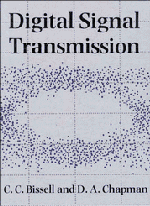Book contents
- Frontmatter
- Contents
- Preface
- 1 Introduction
- PART 1 MODELS
- PART 2 PROCESSES
- PART 3 DIGITAL TRANSMISSION OVER THE PUBLIC SWITCHED TELEPHONE NETWORK
- Appendix A Fourier series and transforms
- Appendix B Convolution
- Appendix C Modelling applications of spreadsheets
- Answers to numerical exercises
- References
- Index
Answers to numerical exercises
Published online by Cambridge University Press: 05 June 2012
- Frontmatter
- Contents
- Preface
- 1 Introduction
- PART 1 MODELS
- PART 2 PROCESSES
- PART 3 DIGITAL TRANSMISSION OVER THE PUBLIC SWITCHED TELEPHONE NETWORK
- Appendix A Fourier series and transforms
- Appendix B Convolution
- Appendix C Modelling applications of spreadsheets
- Answers to numerical exercises
- References
- Index
Summary
Chapter 2
2.1(a) 2.5exp(jωt + π/2) + 2.5exp(–jωt –π/2); double-sided spectral lines of amplitude 2.5, phase ±π/2 at ±ω.
(b) 0.5[exp(jωt) + exp(–jωt)] + 0.25[exp(jωt+π/4) + exp(–jωt–π/4)]; spectral lines of amplitude 0.5, zero phase at ±ω and amplitude 0.25, phase π/4 at ±3ω.
2.2(a) G(0)=10-2Vs, zero crossings every 100 Hz; (b) G(0) = 6.25 x 10-4Vs, zero crossings every 8 kHz.
2.3(a) 0.5 V high extending from -1 to + lms; (b) 10 V high, extending from -0.025 to +0.025 s.
Chapter 3
3.1 V2/3 W.
3.2(a) zero, as there is no d.c. spectral component; (b) 60mV.
3.3 Output mean-square voltage 2 x 10-5 V2. In other words, the first-order filter lets through approximately half as much noise power again as an ideal filter with same cut-off. Alternatively, an ideal filter with a cutoff of πfc/2 would pass the same noise power as the first-order filter.
3.4 The continuous component in each case will be similar to Fig. 3.17(a) but scaled in frequency by a factor of 2 (spectral nulls at integral multiples of 2/T hertz). The bipolar impulse train has no spectral lines, so neither does the RZ bipolar pulse train. The unipolar impulse train has lines at d.c. and all multiples of 1/T; these appear in the spectrum of the RZ pulse train as appropriately scaled lines at d.c, 1/T and frequencies near to side-lobe peaks in the continuous spectral component.
- Type
- Chapter
- Information
- Digital Signal Transmission , pp. 312 - 315Publisher: Cambridge University PressPrint publication year: 1992



